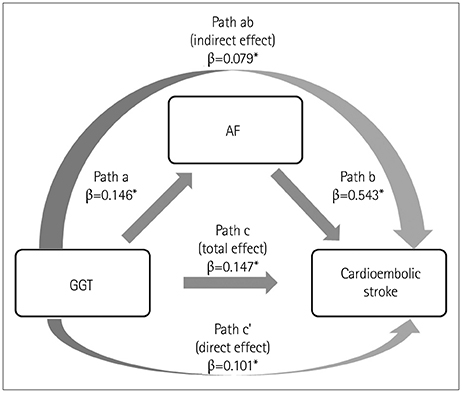J Clin Neurol.
2020 Jan;16(1):60-65. 10.3988/jcn.2020.16.1.60.
Effects of Gamma-Glutamyl Transferase on Stroke Occurrence Mediated by Atrial Fibrillation
- Affiliations
-
- 1Department of Neurology, Seoul National University Hospital, Seoul, Korea. sb0516@snu.ac.kr
- 2The Korean Cerebrovascular Research Institute, Seoul, Korea.
- KMID: 2467785
- DOI: http://doi.org/10.3988/jcn.2020.16.1.60
Abstract
- BACKGROUND AND PURPOSE
Gamma-glutamyl transferase (GGT) is reported to be associated with stroke independently of the conventional risk factors. However, the underlying mechanism remains to be identified. This study focused on atrial fibrillation (AF), which also reportedly has a close association with GGT.
METHODS
Acute ischemic stroke patients who were admitted to the Seoul National University Hospital within 7 days of stroke onset were analyzed. Multinomial logistic regression was performed to assess the relationship between GGT and cardioembolic stroke. Mediation analysis based on binary logistic regression was used to determine whether AF mediates the relationship between GGT and cardioembolic stroke.
RESULTS
AF was found in 132 (15.0%) of 880 eligible patients with acute ischemic stroke, and 270 (30.7%) patients were categorized as cardioembolic stroke. High GGT levels in acute ischemic stroke patients was associated with cardioembolic stroke [odds ratio (OR)=3.42, 95% CI=1.59-7.37], but not with large-artery atherosclerosis stroke (OR=1.10, 95% CI=0.54-2.23). Approximately half (53.9%) of the total effect of GGT levels on cardioembolic stroke was mediated by AF.
CONCLUSIONS
The GGT level was significantly associated with cardioembolic stroke via AF. The results obtained in the present study may explain why GGT is associated with stroke.
MeSH Terms
Figure
Reference
-
1. Wannamethee SG, Lennon L, Shaper AG. The value of gamma-glutamyltransferase in cardiovascular risk prediction in men without diagnosed cardiovascular disease or diabetes. Atherosclerosis. 2008; 201:168–175.
Article2. Strasak AM, Kelleher CC, Klenk J, Brant LJ, Ruttmann E, Rapp K, et al. Longitudinal change in serum gamma-glutamyltransferase and cardiovascular disease mortality: a prospective population-based study in 76,113 Austrian adults. Arterioscler Thromb Vasc Biol. 2008; 28:1857–1865.
Article3. Bots ML, Salonen JT, Elwood PC, Nikitin Y, Freire de Concalves A, Inzitari D, et al. Gamma-glutamyltransferase and risk of stroke: the EUROSTROKE project. J Epidemiol Community Health. 2002; 56 Suppl 1:i25–i29.4. Ebrahim S, Sung J, Song YM, Ferrer RL, Lawlor DA, Davey Smith G. Serum cholesterol, haemorrhagic stroke, ischaemic stroke, and myocardial infarction: Korean national health system prospective cohort study. BMJ. 2006; 333:22.
Article5. Jousilahti P, Rastenyte D, Tuomilehto J. Serum gamma-glutamyl transferase, self-reported alcohol drinking, and the risk of stroke. Stroke. 2000; 31:1851–1855.
Article6. Shimizu Y, Imano H, Ohira T, Kitamura A, Kiyama M, Okada T, et al. Gamma-glutamyltranspeptidase and incident stroke among Japanese men and women: the Circulatory Risk in Communities Study (CIRCS). Stroke. 2010; 41:385–388.
Article7. Weikert C, Drogan D, Di Giuseppe R, Fritsche A, Buijsse B, Nöthlings U, et al. Liver enzymes and stroke risk in middle-aged German adults. Atherosclerosis. 2013; 228:508–514.
Article8. Yang W, Kim CK, Kim DY, Jeong HG, Lee SH. Gamma-glutamyl transferase predicts future stroke: a Korean nationwide study. Ann Neurol. 2018; 83:375–386.
Article9. Alonso A, Misialek JR, Amiin MA, Hoogeveen RC, Chen LY, Agarwal SK, et al. Circulating levels of liver enzymes and incidence of atrial fibrillation: the Atherosclerosis Risk in Communities cohort. Heart. 2014; 100:1511–1516.
Article10. Tekin G, Tekin YK, Senarslan DA, Gocmen AY, Senarslan O, Erbay AR. Serum γ-glutamyltransferase activity in patients with nonvalvular atrial fibrillation. Angiology. 2013; 64:157–160.
Article11. Lee SR, Choi EK, Han KD, Cha MJ, Oh S. Association between γ-glutamyltransferase level and incidence of atrial fibrillation: a nationwide population-based study. Int J Cardiol. 2017; 245:149–155.
Article12. Kunutsor SK, Laukkanen JA, Bluemke DA, Butler J, Khan H. Baseline and long-term gamma-glutamyltransferase, heart failure and cardiac arrhythmias in middle-aged Finnish men: prospective study and pooled analysis of published evidence. Eur J Prev Cardiol. 2016; 23:1354–1362.
Article13. Whitfield JB. Gamma glutamyl transferase. Crit Rev Clin Lab Sci. 2001; 38:263–355.
Article14. Kunutsor SK, Apekey TA, Van Hemelrijck M, Calori G, Perseghin G. Gamma glutamyltransferase, alanine aminotransferase and risk of cancer: systematic review and meta-analysis. Int J Cancer. 2015; 136:1162–1170.
Article15. MacKinnon DP, Dwyer JH. Estimating mediated effects in prevention studies. Eval Rev. 1993; 17:144–158.
Article16. KennyDA. Mediation with dichotomous outcomes [Internet]. Washington, DC: NRHPSYCH;2013. cited 2018 May 12. Available from: http://www.nrhpsych.com/mediation/logmed.html.17. Fox J, Monette G. Generalized collinearity diagnostics. J Am Stat Assoc. 1992; 87:178–183.
Article
- Full Text Links
- Actions
-
Cited
- CITED
-
- Close
- Share
- Similar articles
-
- The Mechanism of and Preventive Therapy for Stroke in Patients with Atrial Fibrillation
- How and When to Screen for Atrial Fibrillation after Stroke: Insights from Insertable Cardiac Monitoring Devices
- The Primary Goal of Anticoagulation in Atrial Fibrillation to Prevent Stroke and Not to Offer the Apparently Cheapest Treatment
- Non-medication Treatment of Atrial Fibrillation
- Cardioembolic Stroke in Atrial Fibrillation-Rationale for Preventive Closure of the Left Atrial Appendage


